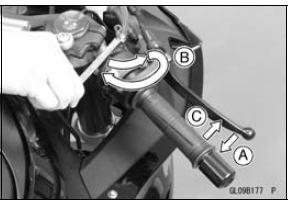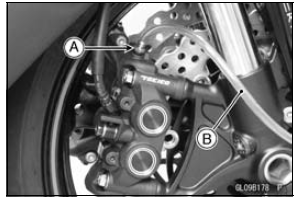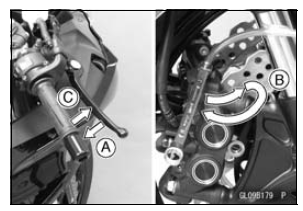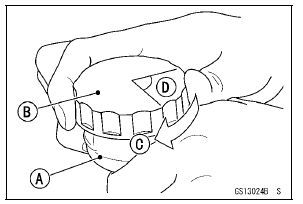

The brake fluid has a very low compression coefficient so that almost all the movement of the brake lever or pedal is transmitted directly to the caliper for braking action. Air, however, is easily compressed. When air enters the brake lines, brake lever or pedal movement will be partially used in compressing the air. This will make the lever or pedal feel spongy, and there will be a loss in braking power.
| WARNING Air in the brake lines diminish braking performance and can cause an accident resulting in injury or death. If the brake lever or pedal has a soft or "spongy" feeling mushy when it is applied, there might be air in the brake lines or the brake may be defective. Do not operate the vehicle and service the brake system immediately. |
NOTE
The procedure to bleed the front brake line is as follows.
Bleeding the rear brake line is the same as for the front brake.


Repeat this operation until no more air can be seen coming out into the plastic hose.
1. Pump the brake lever until it becomes hard, and apply the brake and hold it [A].
2. Quickly open and close [B] the bleed valve while holding the brake applied.
3. Release the brake [C].

NOTE
The fluid level must be checked often during the bleeding operation and replenished with fresh brake fluid as necessary. If the fluid in the reservoir runs completely out any time during bleeding, the bleeding operation must be done over again from the beginning since air will have entered the line.
Torque - Front Master Cylinder Bleed Valve: 5.4 N·m (0.55 kgf·m, 48 in·lb)

Repeat this operation until no more air can be seen coming out into the plastic hose.
1. Pump the brake lever until it becomes hard, and apply the brake and hold it [A].
2. Quickly open and close [B] the bleed valve while holding the brake applied.
3. Release the brake [C].

NOTE
First, tighten the brake fluid reservoir cap [B] clockwise [C] by hand until slight resistance is felt indicating that the cap is seated on the reservoir body, then tighten the cap an additional 1/6 turn [D] while holding the brake fluid reservoir body [A].

Torque - Bleed Valves: 7.8 N·m (0.80 kgf·m, 69 in·lb)
| WARNING When working with the disc brake, observe the precautions listed below.
|
 Brake Fluid Level Inspection
Brake Fluid Level Inspection Brake Hose
Brake HoseZX1000JC /KC
Models
1. Run the fuse box 2 lead in front of the rib for the fuse box 2.
2. Seat Lock Cable
3. Hook the licence plate light lead and the left turn signal light lead on
the projection of the tool
kit case.
4. Rib for Fuse Box 2
5. Run the starter relay lead in back of the rib for the fuse box 2 ...
Release Shaft Installation
Apply grease to the oil seal lips on the upper ridge of the
clutch cover.
Apply engine oil to the needle bearings in the hole of the
clutch cover.
Applymolybdenum disulfide grease to the pusher-holding
portion [A] on the release shaft.
Install the washer [B] and spring [C].
...
Kawasaki Clean Air System
The Kawasaki Clean Air System
(KCA) is a secondary air suction system
that helps the exhaust gases to
burn more completely. When the spent
fuel charge is released into the exhaust
system, it is still hot enough to
burn. The KCA System allows extra
air into the exhaust system so that the
spen ...